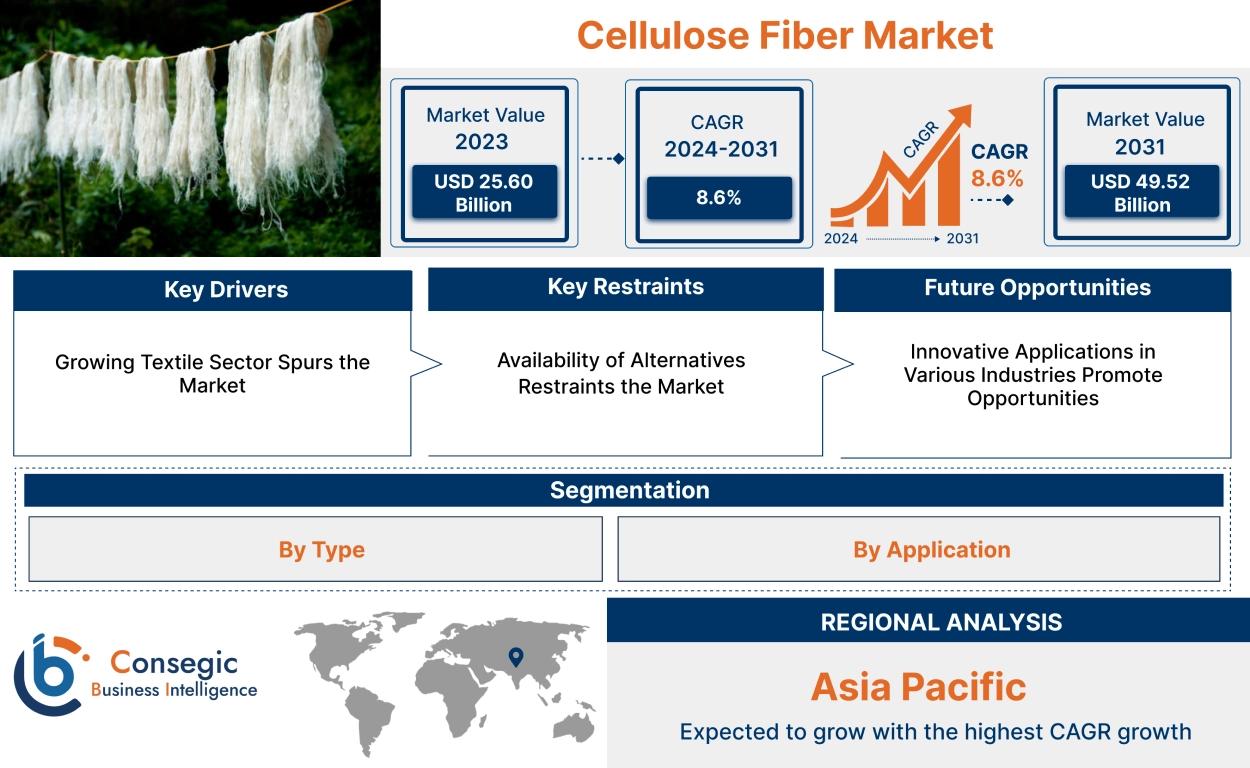Cellulose Fiber Market Size:
Cellulose Fiber Market size is estimated to reach over USD 49.52 Billion by 2031 from a value of USD 25.60 Billion in 2023 and is projected to grow by USD 27.34 Billion in 2024, growing at a CAGR of 8.6% from 2024 to 2031.
Cellulose Fiber Market Scope & Overview:
The cellulose fiber encompasses a broad range of fibers derived from natural sources, primarily wood pulp and cotton. These fibers are widely used in various applications due to their biodegradable and renewable nature, making them a preferred choice in industries increasingly focused on sustainability. The global cellulose fiber market is experiencing robust growth, driven by increasing consumer demand for sustainable and eco-friendly products. This is particularly strong in the textile sector, where these fibers are used extensively in clothing, home textiles, and industrial fabrics.
Cellulose Fiber Market Insights:
Cellulose Fiber Market Dynamics - (DRO) :
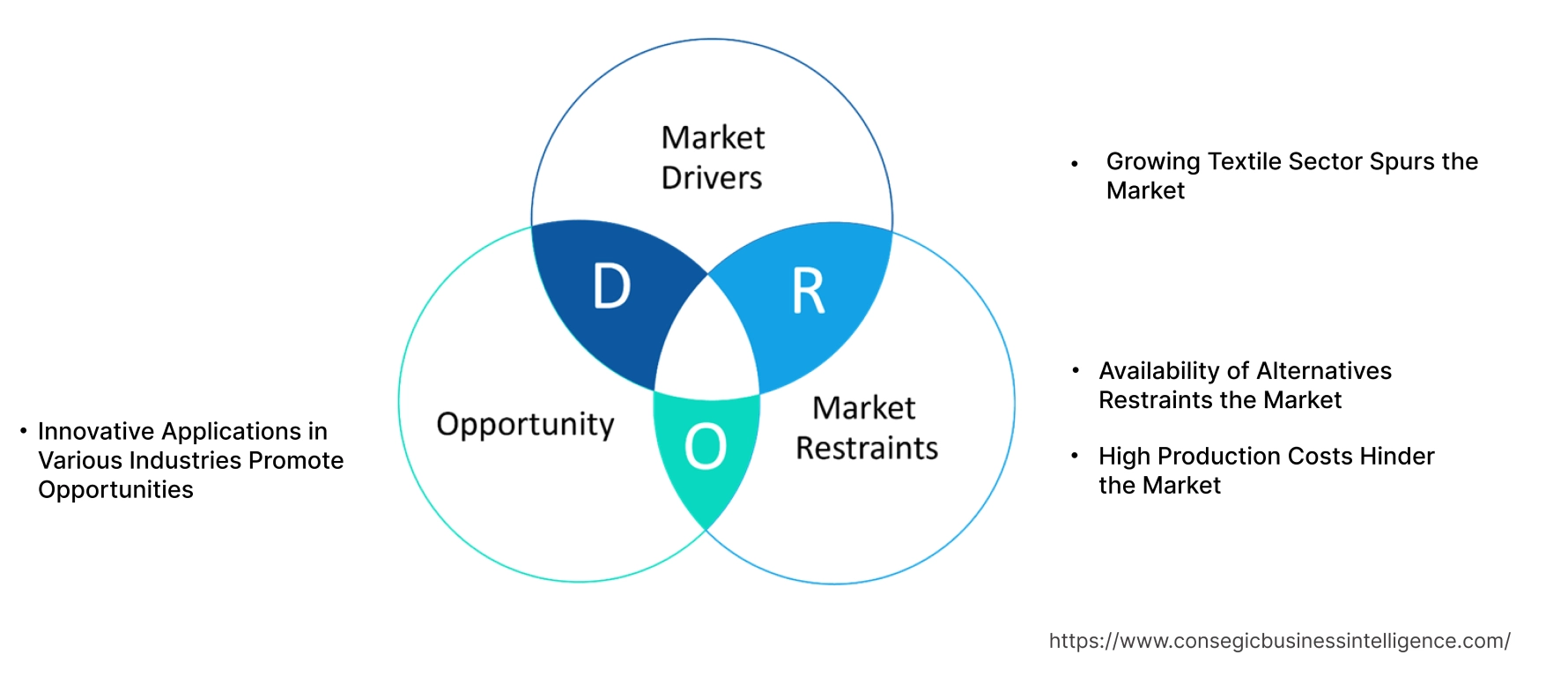
Key Drivers:
Growing Textile Sector Spurs the Market
The textile sector's expansion has led to increased demand for cellulose fibers, which are extensively used in clothing, home textiles, and industrial fabrics. The versatility and sustainability of these fibers make them an attractive choice for various textile applications, contributing to the market's positive trajectory.
- The India Brand Equity Foundation (IBEF) reported that the Indian textile industry is projected to grow at a CAGR of 10% by 2030, highlighting the sector's significant expansion.
Hence, the textile sector is boosting the cellulose fiber market growth.
Key Restraints :
Availability of Alternatives Restraints the Market
The market of cellulose fibers is restrained by the availability of alternatives, particularly cheaper synthetic fibers like polyester and nylon. These synthetic fibers offer cost advantages and have widespread applications, posing a significant challenge to the market expansion of these fibers. Despite the growing preference for sustainable materials, the cost-effectiveness and durability of synthetic fibers often make them the preferred choice for manufacturers and consumers, thereby limiting the potential of these fibers.
- For instance, a market report by Textile Exchange shows that recycled polyester can reach 45% by 2025 in the global textile market.
Thus, the alternate textiles are costing the cellulose fiber market growth.
High Production Costs Hinder the Market
The production of cellulose fibers involves complex processes, including the extraction and purification of cellulose from natural sources, such as wood pulp. These processes are often resource-intensive and require specialized equipment and technology, leading to higher production costs compared to synthetic fibers. Consequently, the cost factor limits the market of these fibers, as manufacturers and consumers may opt for more affordable alternatives.
- For instance, Lyocell, known for its eco-friendly properties, involves a closed-loop process that requires advanced technology and significant investment in specialized equipment. The complexity and cost of this process have led to higher prices for lyocell fibers compared to synthetic alternatives like polyester. This cost disparity can deter manufacturers from adopting lyocell, despite its environmental benefits.
Thus, high production costs are restraining the cellulose fibers market demand the market.
Future Opportunities :
Innovative Applications in Various Industries Promote Opportunities
Expanding the applications of cellulose fibers beyond traditional textiles presents significant opportunities for the market. The innovative use of these fibers in diverse industries—such as healthcare (e.g., wound dressings), packaging, and automotive interiors—creates new avenues for expansion. These applications leverage the unique properties of fibers, such as their biocompatibility and strength, to address emerging needs in various sectors. By diversifying the use of these fibers, companies can tap into new markets, thereby fostering overall market expansion.
Thus, unique innovations in different industries boost the cellulose fiber market opportunities.
Cellulose Fiber Market Segmental Analysis :
By Fiber Type:
Based on the fiber type, the market is segmented into Natural (Silk, Cotton, Linen, Jute, Alpaca, and Wood)) and Man-made (Modal, Rayon, Lyocell, and others).
Trends in the type:
- There is a growing emphasis on improving the sustainability of viscose production. Innovations aim to reduce the environmental impact through more efficient use of resources and reduced emissions. The adoption of closed-loop processes, where solvents are recycled, is becoming more common.
- Analysis shows that efforts are underway to improve the environmental impact of acetate production, although it remains a less sustainable option compared to newer fiber technologies.
The natural segment accounted for the largest revenue in 2023 of the overall cellulose fiber market share and is anticipated to register the fastest CAGR during the forecast period.
- This is driven by the natural fibers inherent sustainability and versatility.
- The preference for natural fibers in various applications, including textiles and industrial uses, highlights their dominant market position.
- For instance, brands like Patagonia and H&M have increasingly incorporated natural cellulose fibers, such as organic cotton and lyocell, into their product lines.
- Thus, the aforementioned factors in the hardware segment are driving the Cellulose Fiber Market trends.
- Thus, the market analysis concludes that natural is driving the cellulose fiber market trends and boosting the market share during the forecast period.
By Application :
Based on the application, the market is segmented into Textiles Processing, Filtration, Papermaking, Hygiene Products, and others.
Trends in the application:
- The papermaking sector is exploring new uses for cellulose fibers in specialty papers, packaging, and even in electronic applications, such as conductive paper and flexible displays.
- The growing trend for these fibers in hygiene products, such as diapers, sanitary napkins, and wipes, is growing. This is driven by the fibers' superior absorbency and softness, which enhance product comfort and performance.
The textile processing segment accounted for the largest revenue share of 58.40%, in 2023.
- This substantial contribution underscores the importance of cellulose fibers in textile manufacturing, where they are extensively used due to their versatile properties and environmental benefits.
- The dominance of this segment highlights the critical role of these fibers in supporting the textile sector's demand for sustainable and high-quality materials.
- For instance, Lenzing AG, which produces Tencel™ has reported increased use of this fiber in various textile applications, including fashion and home textiles.
- Thus, eco-friendly textiles have been driving the cellulose fiber market share.
The filtration segment is anticipated to register the fastest CAGR during the forecast period.
- Filtration involves using cellulose-based materials to separate particles from liquids or gases.
- Cellulose fibers are valued for their high surface area, which enhances their ability to capture impurities efficiently.
- In industries like food and beverage, pharmaceuticals, and water treatment, these fibers are employed to ensure the purity and safety of products.
- Their natural origin and biodegradability also make them an attractive alternative to synthetic filter materials, aligning with growing environmental concerns and regulations.
- This application reflects a broader trend towards sustainable and efficient solutions in industrial filtration processes.
- This expected growth of the filtration segment is driven by the increasing demand for efficient and sustainable filtration solutions across various industries, including water treatment, air purification, and industrial processes.
- The unique properties of these fibers, such as high absorbency and biodegradability, make them an ideal choice for advanced filtration applications, further contributing to the segment's rapid expansion.
- For instance, Aquaporin has been incorporating cellulose-based filters into their water purification products, leveraging the fibers' natural properties to enhance filtration efficiency and sustainability.
- Therefore, the filtration segment is anticipated to boost the cellulose fiber market during the forecast period.
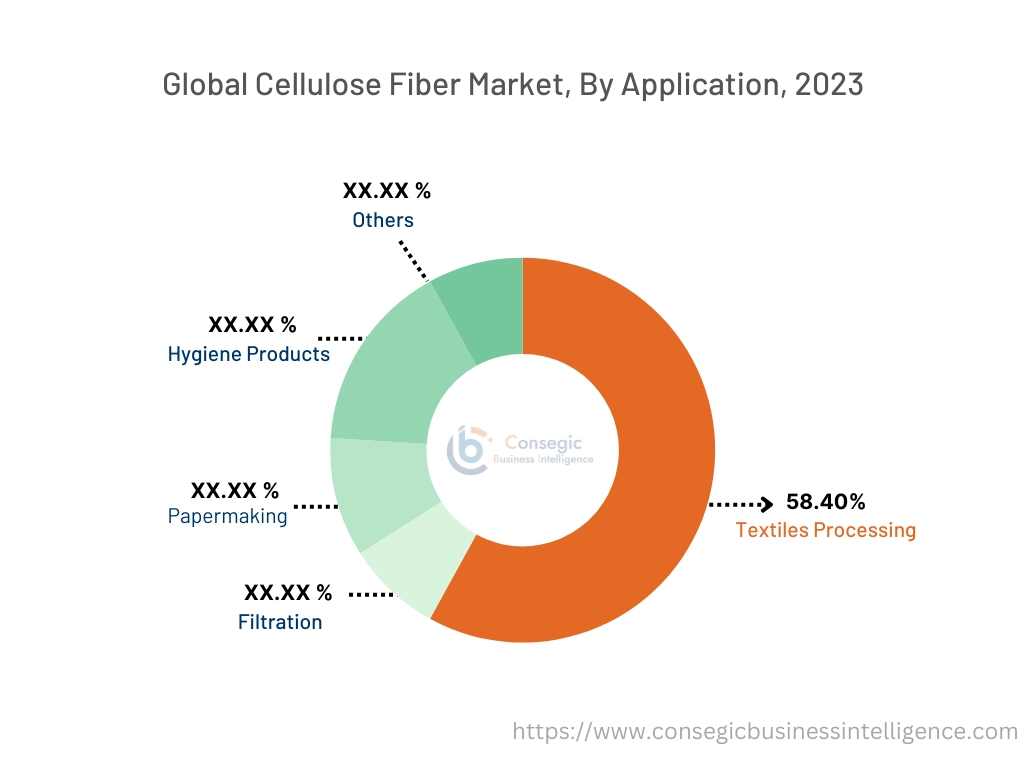
Regional Analysis:
The regions covered are North America, Europe, Asia Pacific, the Middle East and Africa, and Latin America.
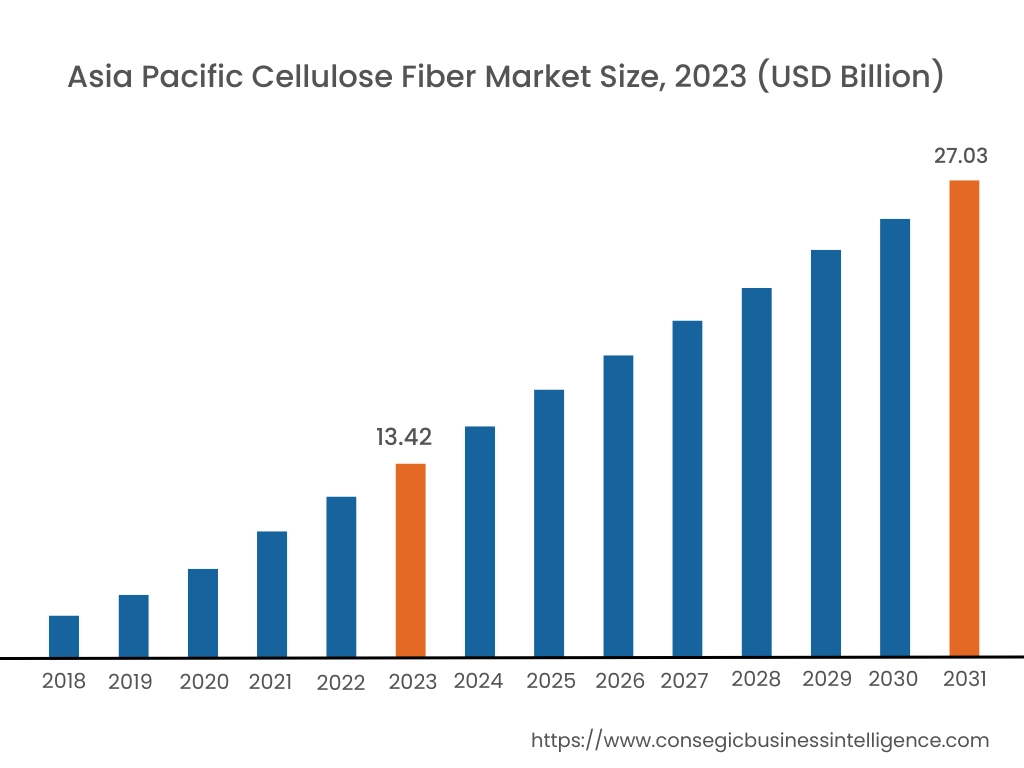
North America is estimated to reach over USD 7.73 Billion by 2031, up from a value of USD 3.97 Billion in 2023. This growth in the cellulose fiber industry is primarily driven by an increasing trend for sustainable and eco-friendly materials in sectors such as textiles, packaging, and automotive interiors. The region's robust industrial base, coupled with rising consumer awareness of environmental issues, contributes to the accelerating adoption of these fibers across various applications.
- For example, companies like Lenzing AG have been increasing their production capacity in the region. Lenzing's investment in its North American facilities underscores the rising demand for sustainable fibers, particularly in textiles and packaging. This expansion reflects the significant market growth and increasing adoption of these fibers in North America.
Asia Pacific region is the fastest and largest growing region and was valued at USD 13.42 Billion in 2023. Moreover, it is projected to grow by USD 14.38 Billion in 2024 and reach over USD 27.03 Billion by 2031. Out of this, China accounted for the maximum revenue share of 42.1%.
This is driven by the region's expanding textile manufacturing sector, increasing consumer demand for sustainable products, and significant investments in production capacity. Countries like China and India are leading this growth due to their large-scale textile industries and burgeoning middle class, which are fueling the fiber trends in various applications, including apparel, home textiles, and industrial uses.
- For instance, India has significantly increased its production of sustainable fibers, including lyocell and viscose, to meet the growing domestic and international trends for eco-friendly textiles. This expansion is supported by both government policies and private sector investments aimed at enhancing the region's position as a leading global supplier of fibers.
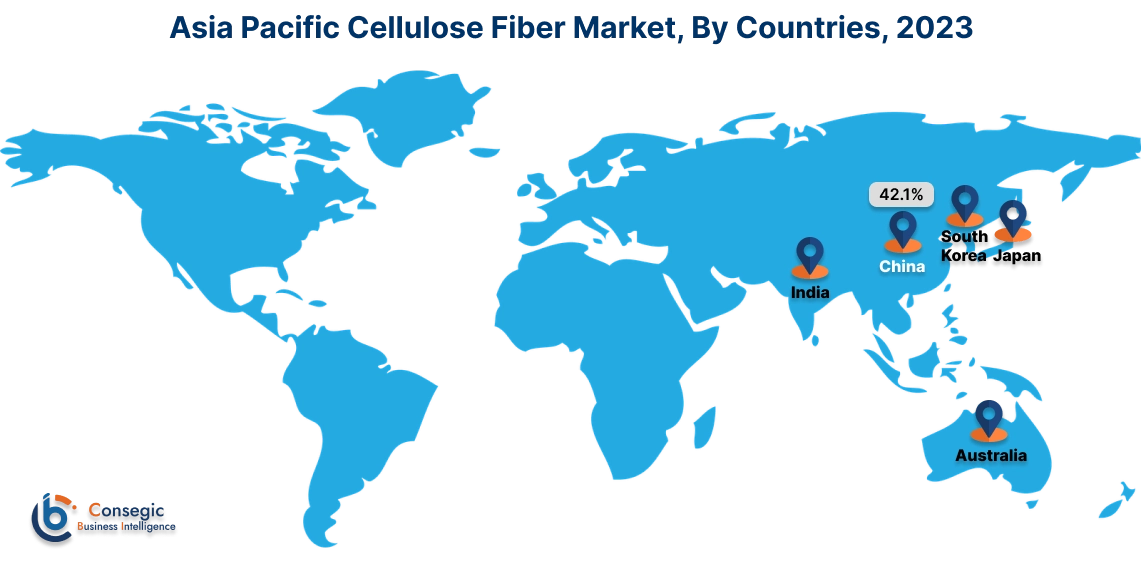
The cellulose fiber market analysis shows that the European region is expected to expand significantly due to the growing need for environmentally friendly and sustainable materials in a variety of industries. The use of these fibers in textile, packaging, and automotive applications is being fuelled by the region's dedication to environmental sustainability and its strict waste and emissions rules. To meet the increasing demand for these fibers, businesses are increasing their production capabilities and investing in cutting-edge technology, solidifying Europe's position as a major participant in the worldwide market.
The cellulose fiber market is anticipated to increase significantly in the Middle East, Africa, and Latin America as a result of rising investments in environmentally friendly production methods and developing industrial sectors. This is driven by the growing emphasis on eco-friendly materials and green technology in nations like Brazil and the United Arab Emirates. The textile and packaging sectors are also expanding in these areas, which is helping to drive the market for these fibers.
Top Key Players & Market Share Insights:
The cellulose fiber market is highly competitive with major players providing products to the national and international markets. Key players are adopting several strategies in research and development (R&D), product innovation, and end-user launches to hold a strong position in the market. Key players in the cellulose fiber industry include-
- Lenzing AG (Austrlia)
- Aditya Birla Management Corporation Pvt. Ltd. (India)
- RYAM (USA)
- Sappi Lanaken Mills (Belgium)
- Asahi Kasei Corporation (Japan)
- Celanese Corporation (USA)
- Shandong Helon Textile Co., Ltd. (China)
- Sateri (China)
- Kraton Corporation (USA)
- Nippon Paper Industries Co., Ltd. (Japan)
Recent Industry Developments :
Product launches
- In March 2024, Lenzing AG launched Tencel Luxe, a new generation of high-quality, sustainable cellulose fibers. This product is designed for luxury and high-performance textiles, enhancing the softness and durability of fabrics while maintaining environmental responsibility.
- In January 2024, Sappi Lanaken Mills introduced a new line of dissolving pulp with enhanced purity and performance characteristics. This product aims to improve the efficiency and sustainability of cellulose fiber production in various applications.
Mergers & Acquisitions
- In September 2023, Rayonier Advanced Materials completed its merger with Tembec, expanding its product offerings and production capabilities in the cellulose fiber market. This merger is expected to enhance their market presence and operational efficiency.
Partnerships & Collaborations
- In December 2023, Birla Cellulose collaborated with Algaeing to develop and introduce a unique, algae-powered cellulosic fiber that is environmentally friendly and offers multiple benefits to the end user.
Cellulose Fiber Market Report Insights :
| Report Attributes | Report Details |
| Study Timeline | 2018-2031 |
| Market Size in 2031 | USD 49.52 Billion |
| CAGR (2024-2031) | 8.6% |
| By Fiber Type |
|
| By Application |
|
| By Region |
|
| Key Players |
|
| North America | U.S. Canada Mexico |
| Europe | U.K. Germany France Spain Italy Russia Benelux Rest of Europe |
| APAC | China South Korea Japan India Australia ASEAN Rest of Asia-Pacific |
| Middle East and Africa | GCC Turkey South Africa Rest of MEA |
| LATAM | Brazil Argentina Chile Rest of LATAM |
| Report Coverage |
|
Key Questions Answered in the Report
How big is the cellulose fiber market? +
Cellulose Fiber Market size is estimated to reach over USD 49.52 Billion by 2031 from a value of USD 25.60 Billion in 2023 and is projected to grow by USD 27.34 Billion in 2024, growing at a CAGR of 8.6% from 2024 to 2031.
Which is the fastest-growing region in the cellulose fiber market? +
Asia-Pacific is the region experiencing the most rapid growth in the cellulose fiber market.
What specific segmentation details are covered in the cellulose fiber report? +
The cellulose fiber report includes specific segmentation details for fiber type, application, and region.
Who are the major players in the cellulose fiber market? +
The key players in the cellulose fiber market are Lenzing AG (Austria), Aditya Birla Management Corporation Pvt. Ltd. (India), Shandong Helon Textile Co., Ltd (China), Sateri (China), RYAM (USA), Sappi Lanaken Mills (Belgium).
